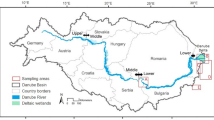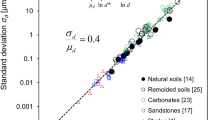Abstract
The difference in pressure between the sea floor and a point in the underlying sediment is an indicator of the velocity of pore-water flow. This differential pore pressure has now been measured at five sites using a free-fall piezometer (pop-up pore pressure instrument, PUPPI) in a distal turbidite province of the Madeira Abyssal Plain. We found that at one of the five sites the pressure was slightly positive, at two others it was effectively zero, but at the remaining two sites the pore pressure was significantly negative (−450 and −120 Pa at 4 m depth). The implication is that at these last two sites water is moving downwards at rates of 3.1 and 0.8 mm yr−1 (calculated using laboratory-measured hydraulic conductivities from core samples). If this downward movement is part of a hydrogeological system which includes upward movement of pore water elsewhere, there are obvious implications for schemes to dispose of highly radioactive waste by burial in deep-sea sediments.
This is a preview of subscription content, access via your institution
Access options
Subscribe to this journal
Receive 51 print issues and online access
$199.00 per year
only $3.90 per issue
Buy this article
- Purchase on Springer Link
- Instant access to full article PDF
Prices may be subject to local taxes which are calculated during checkout
Similar content being viewed by others
References
Corliss, J. B. et al. Science 203, 1073–1083 (1979).
RISE Project Group Science 207, 1421–1433 (1980).
Macdonald, K. C. & Luyendyk, B. B. Earth planet. Sci. Lett. 48, 1–7 (1981).
Anderson, R. N. et al. Nature 300, 589–594 (1982).
Anderson, R. N., Hobart, M. A. & Langseth, M. G. Science 204, 828–832 (1979).
Langseth, M. G. & Herman, B. M. J. geophys. Res. 86, 10805–10819 (1981).
Becker, K. & von Herzen, R. P. J. geophys. Res. 88, 1057–1066 (1983).
Williams, D. L. et al. J. geophys. Res. 84, 7467–7484 (1979).
Abbott, D. H., Menke, W. & Morin, R. J. geophys. Res. 88, 1075–1093 (1983).
Crowe, J. & McDuff, R. E. Eos 60, 863 (1979).
Noel, M. J. Geophys. J. R. astr. Soc. 76, 673–690 (1984).
Schultheiss, P. J., McPhail, S. D., Packwood, A. R. & Hart, B. Inst. oceanogr. Sci. Rep. no. 220 (1985).
Searle, R. C. et al. Inst. oceanogr. Sci. Rep. no. 193 (1985).
Weaver, P. P. E. & Kuijpers, A. Nature 306, 360–363 (1983).
Schultheiss, P. J. & Gunn, D. E. Inst. oceanogr. Sci. Rep. no. 201 (1985).
Weaver, P. P. E. & Schultheiss, P. J. Nature 301, 329–331 (1983).
Author information
Authors and Affiliations
Rights and permissions
About this article
Cite this article
Schultheiss, P., McPhail, S. Direct indication of pore-water advection from pore pressure measurements in Madeira Abyssal Plain sediments. Nature 320, 348–350 (1986). https://doi.org/10.1038/320348a0
Received:
Accepted:
Issue Date:
DOI: https://doi.org/10.1038/320348a0
This article is cited by
-
Pore pressure observation: pressure response of probe penetration and tides
Acta Oceanologica Sinica (2019)
-
Deep sea in situ excess pore pressure and sediment deformation off NW Sumatra and its relation with the December 26, 2004 Great Sumatra-Andaman Earthquake
International Journal of Earth Sciences (2009)
-
Pore pressures in marine sediments: An overview of measurement techniques and some geological and engineering applications
Marine Geophysical Researches (1990)
Comments
By submitting a comment you agree to abide by our Terms and Community Guidelines. If you find something abusive or that does not comply with our terms or guidelines please flag it as inappropriate.



